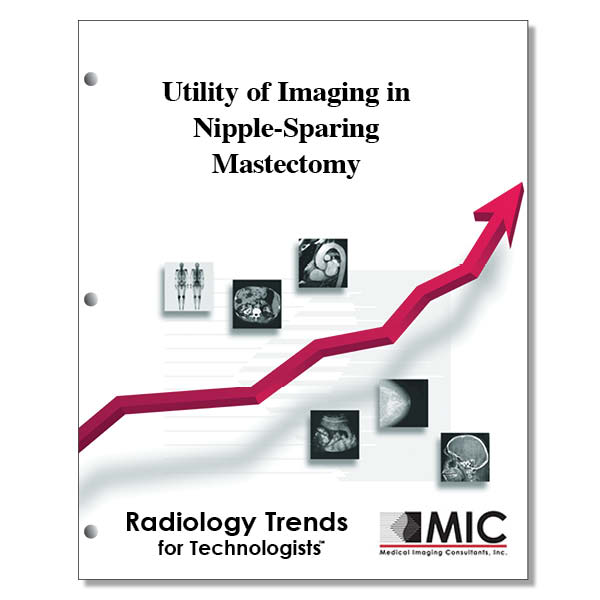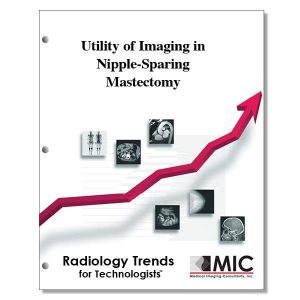

Utility of Imaging in Nipple-Sparing Mastectomy
Since nipple-sparing mastectomy is an increasingly common surgical option for breast cancer patients, imaging is playing a critical role in patient selection. Findings and complications at mammography, US, and MRI are presented.
Course ID: Q00718 Category: Radiology Trends for Technologists Modalities: Mammography, MRI, Radiation Therapy, Sonography2.75 |
Satisfaction Guarantee |
$29.00
- Targeted CE
- Outline
- Objectives
Targeted CE per ARRT’s Discipline, Category, and Subcategory classification:
[Note: Discipline-specific Targeted CE credits may be less than the total Category A credits approved for this course.]
Breast Sonography: 2.75
Patient Care: 0.75
Patient Interactions and Management: 0.75
Procedures: 2.00
Breast Interventions: 2.00
Mammography: 2.75
Patient Care: 1.00
Patient Interactions and Management: 1.00
Procedures: 1.75
Mammographic Positioning, Special Needs, and Imaging Procedures: 1.75
Magnetic Resonance Imaging: 2.25
Procedures: 2.25
Body: 2.25
Registered Radiologist Assistant: 2.75
Procedures: 2.75
Thoracic Section: 2.75
Sonography: 2.00
Procedures: 2.00
Superficial Structures and Other Sonographic Procedures: 2.00
Outline
- Introduction
- Brief Surgical Overview of NSM
- Imaging the NAC
- Mammography
- Ultrasonography
- Breast MRI
- Labeling and Correlating Multimodality Findings
- Candidacy for NSM
- Mammographic Findings that Preclude NSM
- US Findings that Preclude NSM
- MRI Findings that Preclude NSM
- Normal Appearance after NSM and Reconstruction versus Recurrence at Breast MRI
- Flap Reconstruction
- Complications after NSM and Breast Reconstruction
- Imaging Appearance of Recurrence
- Conclusion
Objectives
Upon completion of this course, students will:
- state the most frequently performed surgical treatment for breast cancer
- explain the primary concern with nipple-sparing mastectomyidentify the area of the breast in which cancers arise
- report the percent of tumor recurrence in the nipple areolar complex
- list positive patient outcomes associated with nipple-sparing mastectomy
- list the contraindications for nipple-sparing mastectomy
- list imaging findings that should raise suspicion for malignancy in the nipple areolar complex
- choose procedures that are considered as conservative mastectomy treatment
- describe skin-sparing mastectomy
- explain what the pocket created during nipple-sparing mastectomy may be filled with
- list the complications associated with nipple-sparing mastectomy
- state the percent of nipple necrosis associated with nipple-sparing mastectomy
- describe the normal composition of the nipple areolar complex
- list the normal nipple shapes and sizes
- list the mammographic limitations in evaluating the nipple areolar complex
- choose the correct view to image breast calcifications
- explain how to optimally image the breast at mammography
- list US techniques utilized to obtain diagnostic images of the breast
- recall proper US transducer placement used for the rolled-nipple technique
- choose the imaging modality that is the most sensitive for evaluation of the nipple areolar complex because of its superior soft-tissue contrast and the addition of contrast enhancement
- state when nipple enhancement is best assessed during MRI
- explain the appearance and display of nipples at MRI
- list the four categories of nipple enhancement at MRI
- describe areolar thickening appearance at MRI
- list the patient position for breast imaging in multiple modalities
- explain how to accurately communicate the location and findings of breast disease
- choose which imaging modality has been found to be beneficial before nipple-sparing mastectomy for better visualization of the retroareolar tissue, identification of malignancy, and accurate measurement of the tumor to nipple distance
- list the factors that are highly suggestive of malignancy involving the nipple areolar complex at mammography
- list the type of masses found in the retroareolar location of the breast
- describe common signs of breast malignancy as they relate to the nipple
- explain where nipple areolar complex calcifications can be found in the breast
- choose the views and imaging modalities that can be helpful in determining whether calcifications appear benign or have morphologic characteristics that are suspicious for cancer
- explain how breast malignancies may appear at US
- choose the modality that is the most useful for accurately predicting nipple areolar complex involvement in malignancy
- recall authors of studies that have investigated the use of breast MRI for prediction of neoplastic involvement of the nipple areolar complex
- describe abnormal nipple enhancement at MRI
- describe breast tumor invasion
- state the tumor to nipple distance seen at MRI that indicates a high possibility of malignancy in the nipple areolar complexunderstand the common breast reconstruction techniques
- know which modality is superior in imaging breast flap reconstruction
- recall the skin flap thickness that is associated with a greater number of terminal duct units and the presence of residual disease
- list the complications seen within the first 6 months following breast surgery and autologous reconstruction
- describe the mammographic manifestations of recurrent breast cancer
